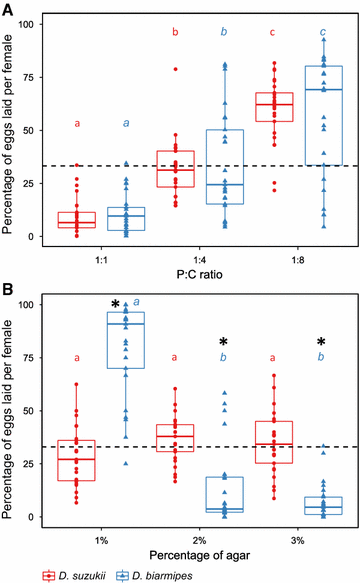Adaptation to new nutritional environments: larval performance, foraging decisions, and adult oviposition choices in Drosophila suzukii
- PMID: 28592264
- PMCID: PMC5463304
- DOI: 10.1186/s12898-017-0131-2
Adaptation to new nutritional environments: larval performance, foraging decisions, and adult oviposition choices in Drosophila suzukii
Abstract
Background: Understanding how species adapt to new niches is a central issue in evolutionary ecology. Nutrition is vital for the survival of all organisms and impacts species fitness and distribution. While most Drosophila species exploit rotting plant parts, some species have diversified to use ripe fruit, allowing earlier colonization. The decomposition of plant material is facilitated by yeast colonization and proliferation. These yeasts serve as the main protein source for Drosophila larvae. This dynamic rotting process entails changes in the nutritional composition of the food and other properties, and animals feeding on material at different stages of decay are expected to have behavioural and nutritional adaptations.
Results: We compared larval performance, feeding behaviour and adult oviposition site choice between the ripe fruit colonizer and invasive pest Drosophila suzukii, and a closely-related rotting fruit colonizer, Drosophila biarmipes. Through the manipulation of protein:carbohydrate ratios in artificial diets, we found that D. suzukii larvae perform better at lower protein concentrations and consume less protein rich diets relative to D. biarmipes. For adult oviposition, these species differed in preference for substrate hardness, but not for the substrate nutritional composition.
Conclusions: Our findings highlight that rather than being an exclusive specialist on ripe fruit, D. suzukii's adaptation to use ripening fruit allow it to colonize a wider range of food substrates than D. biarmipes, which is limited to soft foods with higher protein concentrations. Our results underscore the importance of nutritional performance and feeding behaviours in the colonization of new food niches.
Keywords: Drosophila biarmipes; Drosophila suzukii; Foraging; Niche; Nutrition; Nutritional geometry.
Figures



References
-
- Hutchinson GE. Concluding remarks. Cold Spring Harb Symp Quant Biol. 1957;22:415–427. doi: 10.1101/SQB.1957.022.01.039. - DOI
-
- Appel HM, Martin MM. Significance of metabolic load in the evolution of host specificity of Manduca Sexta. Ecology. 1992;73:216–228. doi: 10.2307/1938733. - DOI
-
- Simpson SJ, Raubenheimer D. A multi-level analysis of feeding behaviour: the geometry of nutritional decisions. Philos Trans R Soc B. 1993;342:381–402. doi: 10.1098/rstb.1993.0166. - DOI
Publication types
MeSH terms
LinkOut - more resources
Full Text Sources
Other Literature Sources
Molecular Biology Databases

